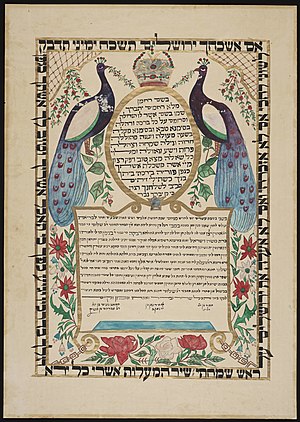
Invited to a Jewish wedding? Not sure what to expect? Here are some Jewish wedding traditions you may encounter.
HEBREW IN THE INVITATION – One wedding custom is to have everything on the invitation in both Hebrew and in English. Don’t worry, the translation is right there in front of you. No one will expect you to speak Hebrew at the wedding, except perhaps for Mazal Tov [Congratulations].
WHAT SHOULD I WEAR? – The invitation will probably tell you what you need to know (“formal,” “black-tie,” etc.) If the wedding is Orthodox, there may be expectations about modesty for women (no miniskirts, décolletage, etc.) If you have any questions about what to wear, call well ahead of time to ask.
WHAT CUSTOMS ARE DIFFERENT FROM A CHRISTIAN WEDDING? There are a number of distinct Jewish wedding customs. You may see some or all of these:
- KETUBAH – A wedding contract, signed before the wedding begins or as it starts.
- BEDECKEN – Bedecken, “veiling” is a formal visit to the bride by the groom and his party just before the wedding (she and her attendants are in a separate room) and the groom sees her before she is veiled. This goes back to a Biblical story in which Jacob married the wrong woman when his fiance’s family deceived him.
- CHUPPAH – The chuppah is a wedding canopy that symbolizes the new household that comes into being with this wedding. The bride and groom and their parents stand beneath it.
- CIRCLING – The bride may walk seven circles around the groom during the ceremony, or in an egalitarian service, the couple may circle one another. Their lives will revolve around each other from now on.
- PLAIN RING – For Jewish law, only one ring is required, given by the groom to the bride. It is a plain ring made of precious metal. The origin of this custom is that the groom is giving the bride an object of verifiable value as part of the wedding contract. Some couples use a plain ring that is in the groom’s family for this purpose, but the ring that the bride will wear after the ceremony is a ring with stones.
- HEBREW VOW – The vow is usually in Hebrew, with the giving of the ring(s). The translation of the vow is “Behold, you are consecrated to me with this ring, according to the law of Moses and Israel.”
- SHEVA BRACHOT – “Seven blessings” – These blessings are sung in Hebrew for the bride and groom. They celebrate not only this wedding, but the addition of a new household to the Jewish People.
- BREAKING THE GLASS – The rabbi wraps a glass in cloth; the groom crushes it with his foot and everyone cries “Mazal tov!” There are many different stories about this custom.
- DANCE THE HORA – At the reception, you may be invited to dance the hora – it’s a big circle dance, and if you “go with the flow” you won’t get in much trouble.
HOW CAN I BE A GOOD GUEST? Mostly, do the same things you’d do at any wedding: be happy for the couple, be pleasant to other guests, don’t drink too much, and so on. When in doubt, copy other guests who are near your age and gender.
The descriptions above deal with a traditional Jewish wedding between a bride and a groom. I’ll write about same-sex ceremonies and egalitarian practices in future posts.
A Jewish wedding is a time of great rejoicing, not only for the bride and groom, but for their families and for the greater Jewish community. Have a great time at the wedding!
Related articles
- A Perfect Wedding Guest: A Jewish Perspective (oakvillenews.org)
- Why I Heart Chuppahs (alwaysablogsmaid.com)
- If I forget thee O Jerusalem (bokertov.typepad.com)
